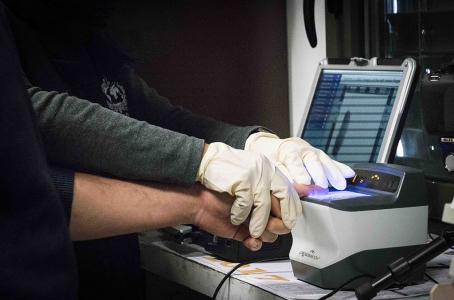A unique identifier
Fingerprinting is one form of biometrics, a science which uses people’s physical or biological characteristics to identify them.
No two people have the same fingerprints, not even identical twins. Neither do fingerprints change, even as we get older, unless the deep or ‘basal’ layer is destroyed or intentionally changed by plastic surgery.
There are three main fingerprint patterns, called arches, loops and whorls. The shape, size, number and arrangement of minor details in these patterns make each fingerprint unique.

Making a match
When a fingerprint is found at a crime scene it is known as a ‘finger mark’ or ‘latent print’. Cross-checking these against other prints in police databases has the potential to link a series of crimes together, or to place a suspect at the scene of a crime.
INTERPOL runs an international fingerprint database known as the automatic fingerprint identification system (AFIS).
Authorized users in member countries can cross-check records from their national fingerprint databases against AFIS, where they think there may be an international aspect to the crime. The AFIS contains more than 220,000 fingerprint records and more than 17,000 crime scene marks.
The exchange of forensic data in international investigations is a fundamental aspect of INTERPOL’s policing capabilities.
Technology and innovation
Through the AFIS gateway, users receive the results of their checks very quickly:
- For individuals who are unknown in the database, this takes only a few minutes (automatic search)
- For individuals known in the database, this takes about an hour (semi-automatic search)
- For unidentified latent prints from a crime scene, this takes about an hour (manual process)
The automated process means the database can make more than 3,000 comparisons per day. The system is also capable of searching and filing palm prints.
New ABIS (automated biometric identification system) technology will be implemented in the future to enable faster and more accurate searches. It will also integrate with a new biometric hub to allow a streamlined search across all INTERPOL forensic databases. This will save valuable time and reveal connections that could otherwise go unnoticed.
Exchanging fingerprint records using the NIST standard
Fingerprints can be taken with an electronic scanning device or manually, using ink and paper. A scanner is then used to save the data electronically in the appropriate format.
Records are saved and exchanged in the format set by the National Institute of Standards and Technology (NIST). INTERPOL publishes a technical document with implementation guidelines for the exchange of biometric data in line with this format. The latest version (v. 6.0), published in 2020, introduces the use of XML and will, in future, replace the previous version (v5.03).
Both sets of guidelines and the related file package can be downloaded from our GitHub platform. Any feedback, questions or problems can be submitted via the Issues page.
To facilitate the transfer of fingerprint data, INTERPOL has made a tool available to member countries which converts JPEG files into NIST files (Image2NIST).
Identifying victims of disasters
Along with DNA, fingerprints can play an important role in identifying victims following natural or manmade disasters such as an earthquake or bombing. This is important not only for the police investigating the incident, but also for the families concerned.
Gathering experts together
Held every two years, INTERPOL’s International Fingerprint and Face Symposium provides an opportunity for experts from around the world to share best practice and latest developments.
An INTERPOL AFIS expert working group meets twice a year to share information on new technology, identification procedures and training needs. It also makes sure INTERPOL’s systems comply with the necessary standards.
Training
We also provide training to police in our member countries, to ensure that frontline officers have the knowledge and skills necessary to assess, preserve and share evidence in line with best practices.
Related documents







